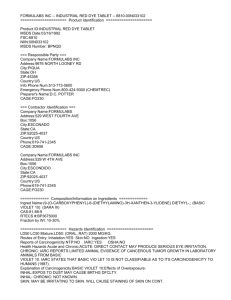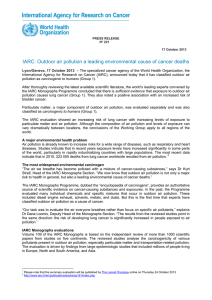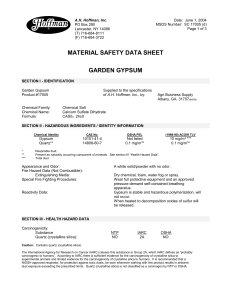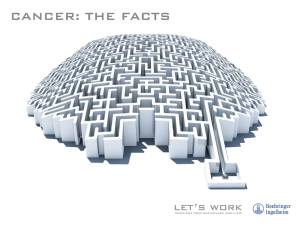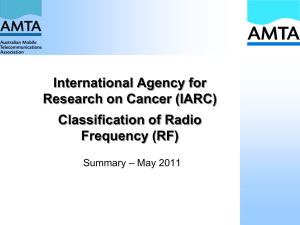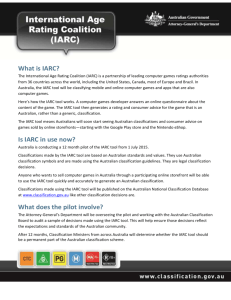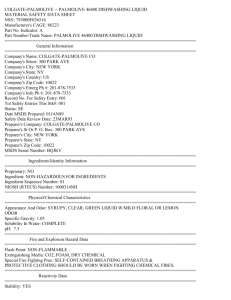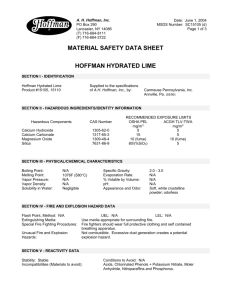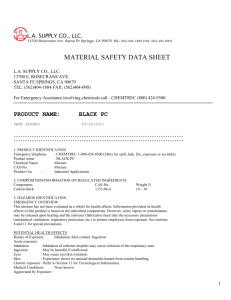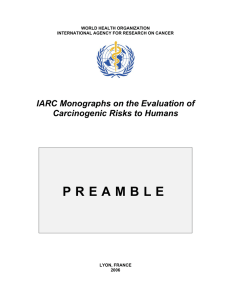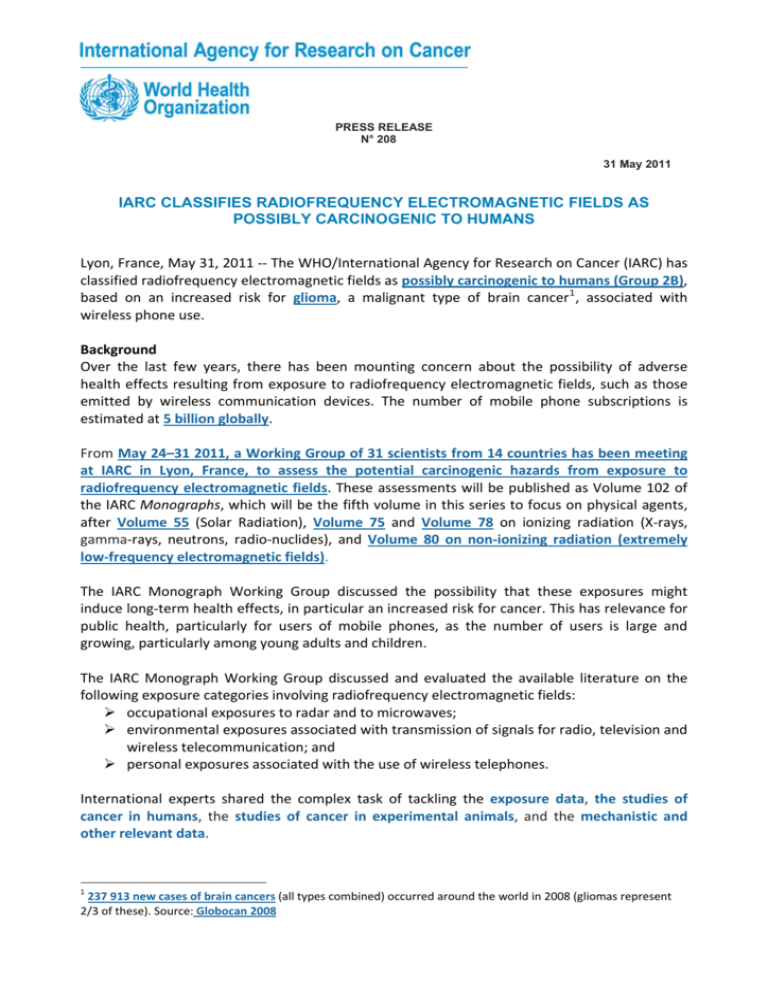
PRESS RELEASE
N° 208
31 May 2011
IARC CLASSIFIES RADIOFREQUENCY ELECTROMAGNETIC FIELDS AS
POSSIBLY CARCINOGENIC TO HUMANS
Lyon, France, May 31, 2011 ‐‐ The WHO/International Agency for Research on Cancer (IARC) has classified radiofrequency electromagnetic fields as possibly carcinogenic to humans (Group 2B), based on an increased risk for glioma, a malignant type of brain cancer 1 , associated with wireless phone use. Background Over the last few years, there has been mounting concern about the possibility of adverse health effects resulting from exposure to radiofrequency electromagnetic fields, such as those emitted by wireless communication devices. The number of mobile phone subscriptions is estimated at 5 billion globally. From May 24–31 2011, a Working Group of 31 scientists from 14 countries has been meeting at IARC in Lyon, France, to assess the potential carcinogenic hazards from exposure to radiofrequency electromagnetic fields. These assessments will be published as Volume 102 of the IARC Monographs, which will be the fifth volume in this series to focus on physical agents, after Volume 55 (Solar Radiation), Volume 75 and Volume 78 on ionizing radiation (X‐rays, gamma‐rays, neutrons, radio‐nuclides), and Volume 80 on non‐ionizing radiation (extremely low‐frequency electromagnetic fields). The IARC Monograph Working Group discussed the possibility that these exposures might induce long‐term health effects, in particular an increased risk for cancer. This has relevance for public health, particularly for users of mobile phones, as the number of users is large and growing, particularly among young adults and children. The IARC Monograph Working Group discussed and evaluated the available literature on the following exposure categories involving radiofrequency electromagnetic fields: ¾ occupational exposures to radar and to microwaves; ¾ environmental exposures associated with transmission of signals for radio, television and wireless telecommunication; and ¾ personal exposures associated with the use of wireless telephones. International experts shared the complex task of tackling the exposure data, the studies of cancer in humans, the studies of cancer in experimental animals, and the mechanistic and other relevant data. 1
237 913 new cases of brain cancers (all types combined) occurred around the world in 2008 (gliomas represent 2/3 of these). Source: Globocan 2008
Page 2
IARC CLASSIFIES RADIOFREQUENCY ELECTROMAGNETIC FIELDS AS
POSSIBLY CARCINOGENIC TO HUMANS
Results The evidence was reviewed critically, and overall evaluated as being limited 2 among users of wireless telephones for glioma and acoustic neuroma, and inadequate 3 to draw conclusions for other types of cancers. The evidence from the occupational and environmental exposures mentioned above was similarly judged inadequate. The Working Group did not quantitate the risk; however, one study of past cell phone use (up to the year 2004), showed a 40% increased risk for gliomas in the highest category of heavy users (reported average: 30 minutes per day over a 10‐year period). Conclusions Dr Jonathan Samet (University of Southern California, USA), overall Chairman of the Working Group, indicated that "the evidence, while still accumulating, is strong enough to support a conclusion and the 2B classification. The conclusion means that there could be some risk, and therefore we need to keep a close watch for a link between cell phones and cancer risk." "Given the potential consequences for public health of this classification and findings," said IARC Director Christopher Wild, "it is important that additional research be conducted into the long‐
term, heavy use of mobile phones. Pending the availability of such information, it is important to take pragmatic measures to reduce exposure such as hands‐free devices or texting. " The Working Group considered hundreds of scientific articles; the complete list will be published in the Monograph. It is noteworthy to mention that several recent in‐press scientific articles 4 resulting from the Interphone study were made available to the working group shortly before it was due to convene, reflecting their acceptance for publication at that time, and were included in the evaluation. A concise report summarizing the main conclusions of the IARC Working Group and the evaluations of the carcinogenic hazard from radiofrequency electromagnetic fields (including the use of mobile telephones) will be published in The Lancet Oncology in its July 1 issue, and in a few days online. 2
'Limited evidence of carcinogenicity': A positive association has been observed between exposure to the agent and cancer for which a causal interpretation is considered by the Working Group to be credible, but chance, bias or confounding could not be ruled out with reasonable confidence. 3
'Inadequate evidence of carcinogenicity': The available studies are of insufficient quality, consistency or statistical power to permit a conclusion regarding the presence or absence of a causal association between exposure and cancer, or no data on cancer in humans are available. 4
a. 'Acoustic neuroma risk in relation to mobile telephone use: results of the INTERPHONE international case‐
control study' (the Interphone Study Group, in Cancer Epidemiology, in press) b. 'Estimation of RF energy absorbed in the brain from mobile phones in the Interphone study' (Cardis et al., Occupational and Environmental Medicine, in press) c. 'Risk of brain tumours in relation to estimated RF dose from mobile phones – results from five Interphone countries' (Cardis et al., Occupational and Environmental Medicine, in press) d. 'Location of Gliomas in Relation to Mobile Telephone Use: A Case‐Case and Case‐Specular Analysis' (American Journal of Epidemiology, May 24, 2011. [Epub ahead of print]. IARC, 150 Cours Albert Thomas, 69372 Lyon CEDEX 08, France - Tel: +33 (0)4 72 73 84 85 - Fax: +33 (0)4 72 73 85 75
© IARC 2011 - All Rights Reserved.
Page 3
IARC CLASSIFIES RADIOFREQUENCY ELECTROMAGNETIC FIELDS AS
POSSIBLY CARCINOGENIC TO HUMANS
For more information, please contact Dr Kurt Straif, IARC Monographs Section, at +33 472 738 511, or straif@iarc.fr; Dr Robert Baan, IARC Monographs Section, at +33 472 738 659, or baan@iarc.fr; or Nicolas Gaudin, IARC Communications Group, at com@iarc.fr (+33 472 738 478) Link to the audio file posted shortly after the briefing: http://terrance.who.int/mediacentre/audio/press_briefings/ About IARC The International Agency for Research on Cancer (IARC) is part of the World Health Organization. Its mission is to coordinate and conduct research on the causes of human cancer, the mechanisms of carcinogenesis, and to develop scientific strategies for cancer control. The Agency is involved in both epidemiological and laboratory research and disseminates scientific information through publications, meetings, courses, and fellowships. If you wish your name to be removed from our press release e‐mailing list, please write to com@iarc.fr. Nicolas Gaudin, Ph.D. Head, IARC Communications
International Agency for Research on Cancer
World Health Organization 150, cours Albert‐Thomas 69008 Lyon France Email com@iarc.fr
http://www.iarc.fr/ IARC, 150 Cours Albert Thomas, 69372 Lyon CEDEX 08, France - Tel: +33 (0)4 72 73 84 85 - Fax: +33 (0)4 72 73 85 75
© IARC 2011 - All Rights Reserved.
Page 4
IARC CLASSIFIES RADIOFREQUENCY ELECTROMAGNETIC FIELDS AS
POSSIBLY CARCINOGENIC TO HUMANS
ABOUT THE IARC MONOGRAPHS
What are the IARC Monographs? The IARC Monographs identify environmental factors that can increase the risk of human cancer. These include chemicals, complex mixtures, occupational exposures, physical and biological agents, and lifestyle factors. National health agencies use this information as scientific support for their actions to prevent exposure to potential carcinogens. Interdisciplinary working groups of expert scientists review the published studies and evaluate the weight of the evidence that an agent can increase the risk of cancer. The principles, procedures, and scientific criteria that guide the evaluations are described in the Preamble to the IARC Monographs. Since 1971, more than 900 agents have been evaluated, of which approximately 400 have been identified as carcinogenic or potentially carcinogenic to humans. Definitions
Group 1: The agent is carcinogenic to humans. This category is used when there is sufficient evidence of carcinogenicity in humans. Exceptionally, an agent may be placed in this category when evidence of carcinogenicity in humans is less than sufficient but there is sufficient evidence of carcinogenicity in experimental animals and strong evidence in exposed humans that the agent acts through a relevant mechanism of carcinogenicity. Group 2. This category includes agents for which, at one extreme, the degree of evidence of carcinogenicity in humans is almost sufficient, as well as those for which, at the other extreme, there are no human data but for which there is evidence of carcinogenicity in experimental animals. Agents are assigned to either Group 2A (probably carcinogenic to humans) or Group 2B (possibly carcinogenic to humans) on the basis of epidemiological and experimental evidence of carcinogenicity and mechanistic and other relevant data. The terms probably carcinogenic and possibly carcinogenic have no quantitative significance and are used simply as descriptors of different levels of evidence of human carcinogenicity, with probably carcinogenic signifying a higher level of evidence than possibly carcinogenic. Group 2A: The agent is probably carcinogenic to humans. This category is used when there is limited evidence of carcinogenicity in humans and sufficient evidence of carcinogenicity in experimental animals. In some cases, an agent may be classified in this category when there is inadequate evidence of carcinogenicity in humans and sufficient evidence of carcinogenicity in experimental animals and strong evidence that the carcinogenesis is mediated by a mechanism that also operates in humans. Exceptionally, an agent may be classified in this category solely on the basis of limited evidence of carcinogenicity in humans. An agent may be assigned to this category if it clearly belongs, based on mechanistic considerations, to a class of agents for which one or more members have been classified in Group 1 or Group 2A. IARC, 150 Cours Albert Thomas, 69372 Lyon CEDEX 08, France - Tel: +33 (0)4 72 73 84 85 - Fax: +33 (0)4 72 73 85 75
© IARC 2011 - All Rights Reserved.
Page 5
IARC CLASSIFIES RADIOFREQUENCY ELECTROMAGNETIC FIELDS AS
POSSIBLY CARCINOGENIC TO HUMANS
Group 2B: The agent is possibly carcinogenic to humans. This category is used for agents for which there is limited evidence of carcinogenicity in humans and less than sufficient evidence of carcinogenicity in experimental animals. It may also be used when there is inadequate evidence of carcinogenicity in humans but there is sufficient evidence of carcinogenicity in experimental animals. In some instances, an agent for which there is inadequate evidence of carcinogenicity in humans and less than sufficient evidence of carcinogenicity in experimental animals together with supporting evidence from mechanistic and other relevant data may be placed in this group. An agent may be classified in this category solely on the basis of strong evidence from mechanistic and other relevant data. Group 3: The agent is not classifiable as to its carcinogenicity to humans. This category is used most commonly for agents for which the evidence of carcinogenicity is inadequate in humans and inadequate or limited in experimental animals. Exceptionally, agents for which the evidence of carcinogenicity is inadequate in humans but sufficient in experimental animals may be placed in this category when there is strong evidence that the mechanism of carcinogenicity in experimental animals does not operate in humans. Agents that do not fall into any other group are also placed in this category. An evaluation in Group 3 is not a determination of non‐carcinogenicity or overall safety. It often means that further research is needed, especially when exposures are widespread or the cancer data are consistent with differing interpretations. Group 4: The agent is probably not carcinogenic to humans. This category is used for agents for which there is evidence suggesting lack of carcinogenicity in humans and in experimental animals. In some instances, agents for which there is inadequate evidence of carcinogenicity in humans but evidence suggesting lack of carcinogenicity in experimental animals, consistently and strongly supported by a broad range of mechanistic and other relevant data, may be classified in this group. Definitions of evidence, as used in IARC Monographs for studies in humans
The evidence relevant to carcinogenicity from studies in humans is classified into one of the following categories: Sufficient evidence of carcinogenicity: The Working Group considers that a causal relationship has been established between exposure to the agent and human cancer. That is, a positive relationship has been observed between the exposure and cancer in studies in which chance, bias and confounding could be ruled out with reasonable confidence. A statement that there is sufficient evidence is followed by a separate sentence that identifies the target organ(s) or tissue(s) where an increased risk of cancer was observed in humans. Identification of a specific target organ or tissue does not preclude the possibility that the agent may cause cancer at other sites. IARC, 150 Cours Albert Thomas, 69372 Lyon CEDEX 08, France - Tel: +33 (0)4 72 73 84 85 - Fax: +33 (0)4 72 73 85 75
© IARC 2011 - All Rights Reserved.
Page 6
IARC CLASSIFIES RADIOFREQUENCY ELECTROMAGNETIC FIELDS AS
POSSIBLY CARCINOGENIC TO HUMANS
Limited evidence of carcinogenicity: A positive association has been observed between exposure to the agent and cancer for which a causal interpretation is considered by the Working Group to be credible, but chance, bias or confounding could not be ruled out with reasonable confidence. Inadequate evidence of carcinogenicity: The available studies are of insufficient quality, consistency or statistical power to permit a conclusion regarding the presence or absence of a causal association between exposure and cancer, or no data on cancer in humans are available. Evidence suggesting lack of carcinogenicity: There are several adequate studies covering the full range of levels of exposure that humans are known to encounter, which are mutually consistent in not showing a positive association between exposure to the agent and any studied cancer at any observed level of exposure. The results from these studies alone or combined should have narrow confidence intervals with an upper limit close to the null value (e.g. a relative risk of 1.0). Bias and confounding should be ruled out with reasonable confidence, and the studies should have an adequate length of follow‐up. A conclusion of evidence suggesting lack of carcinogenicity is inevitably limited to the cancer sites, conditions and levels of exposure, and length of observation covered by the available studies. In addition, the possibility of a very small risk at the levels of exposure studied can never be excluded. In some instances, the above categories may be used to classify the degree of evidence related to carcinogenicity in specific organs or tissues. IARC, 150 Cours Albert Thomas, 69372 Lyon CEDEX 08, France - Tel: +33 (0)4 72 73 84 85 - Fax: +33 (0)4 72 73 85 75
© IARC 2011 - All Rights Reserved.

